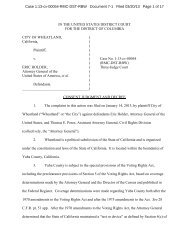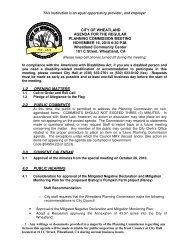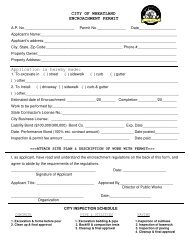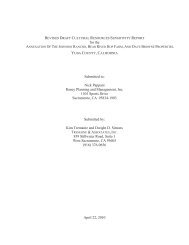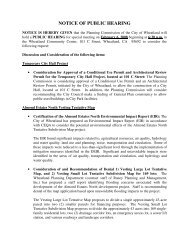General Plan Policy Document (Adopted 7-11 ... - City of Wheatland
General Plan Policy Document (Adopted 7-11 ... - City of Wheatland
General Plan Policy Document (Adopted 7-11 ... - City of Wheatland
You also want an ePaper? Increase the reach of your titles
YUMPU automatically turns print PDFs into web optimized ePapers that Google loves.
GENERAL PLAN SUMMARYWHEATLAND’SHISTORICALDEVELOPMENTEarlyEuropeanSettlementline. The larger Study Area encompasses approximately 24,300 acres<strong>of</strong> land in which information has been collected for the <strong>General</strong> <strong>Plan</strong>Update. Figure 2 shows the boundaries <strong>of</strong> the <strong>Plan</strong>ning Area andStudy Area.The <strong>General</strong> <strong>Plan</strong>’s Study Area lies within the territory once claimedby the Valley Nisenan (or Southern Maidu) which are a Penutianspeakingcentral California group. Their traditional homelands onceincluded the lower drainages <strong>of</strong> the American, Yuba, and Bear Rivers,and the lower reaches <strong>of</strong> the Feather River.Few villages occupied the valley plain between the Sacramento Riverand the foothills. Although both the valley and foothill people huntedand gathered there, the resource focus was along the edges <strong>of</strong> richecotones, either the rivers and the valley floor, or the valley floor andthe foothills. The plains surrounding <strong>Wheatland</strong> fall in between thesetwo rich ecotones, and consist <strong>of</strong> exposed terrain. It is not likely thatNative Americans would have spent an appreciable amount <strong>of</strong> time inthe <strong>Wheatland</strong> area, instead they would have resided in villages alongthe Yuba River to the north and the hills to the east.Early European settlement in the <strong>Wheatland</strong> area came withexpeditions led by Gabriel Moraga in 1808 and Luis Arguello in 1821,both <strong>of</strong> whom crossed portions <strong>of</strong> present day Yuba County.Throughout the 1820s and 1830s, Yuba County was visited by trappersfrom the Hudson’s Bay Company and American Fur Company, whoexploited beaver and other fur resources.In 1822 California came under Mexican rule when Mexico becameindependent <strong>of</strong> Spain. As British and Americans were allowed tobecome Mexican citizens, they acquired large tracts <strong>of</strong> land granted tothem by Mexico and initially dominated the business and commercialaffairs <strong>of</strong> the region. John Sutter established land holdings thatincluded much <strong>of</strong> what is now Yuba County. Sutter owned more thanMexican law permitted; therefore, he sublet parts <strong>of</strong> his estate to othersettlers. In 1844, a Mexican who had been in the employ <strong>of</strong> Sutter, DonPablo Guttierez, obtained a grant <strong>of</strong> five leagues on the north side <strong>of</strong>Bear River, now known as the Johnson Grant. The land grant, datedDecember 22, 1844, was first known as Rancho de Pablo, for PabloGuttierez, the grantee. <strong>Wheatland</strong> falls within the center <strong>of</strong> this landgrant.By 1849 there were a number <strong>of</strong> settlements along Bear Riverestablished by people engaged in mining, the livestock trade, tradingpost, sawmills, hotels, cutting hay, and raising cattle. Johnson’s Ranchprovided a way station for teams engaging in hauling freight fromSacramento to the northern mines. It also became a stopping place fortrappers, explorers, and travelers.<strong>Wheatland</strong> <strong>General</strong> <strong>Plan</strong> <strong>Policy</strong> <strong>Document</strong>, Part I 4July <strong>11</strong>, 2006



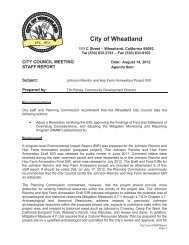
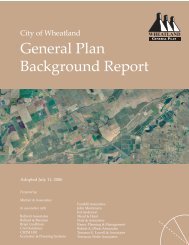
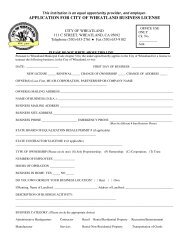

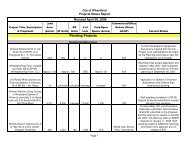
![[Read-Only].pdf - City of Wheatland - State of California](https://img.yumpu.com/37333564/1/190x146/read-onlypdf-city-of-wheatland-state-of-california.jpg?quality=85)
